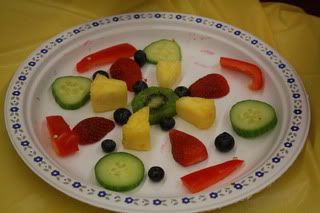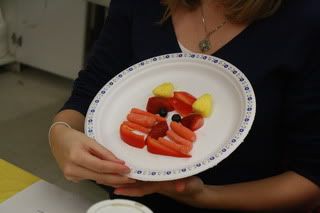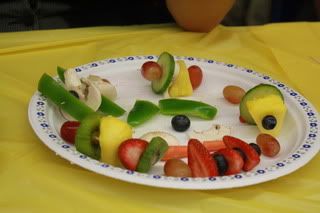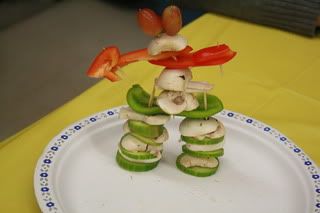
Art Cross Curricular Lesson
Jennifer Brine and Stephanie Brown MSVU 2010
Grade 1 Health with Social Studies and Math Skills
Objectives: Students will learn about healthy eating and how healthy food can inspire them artistically while drawing on social studies and math development skills. This will all be done using the artist Giuseppe Arcimboldo as an example.
Projected Specific Curricular Outcomes:
Health: A2.1, B1.1, B1.3, B1.4, B5.1, D1.1,
Language Arts: 1.1, 1.2, 1.3, 1.4, 2.1, 2.4, 4.6,
Math: A1, A5, B3, C1, C4, E1, E2, E3, E6,E7,E8,E9,E10
Science: Majority of specific outcomes for senses (are not numerically listed) as well as constructing objects (also not numerically listed)
Social Studies: 1.2.2, 1.2.3
Visual Arts: 1.1, 1.2, 1.3, 2.1, 3.1, 3.3, 4.1, 4.2, 4.3,5.1, 5.2
General outcomes: Learning a fact about each food related to social studies, general math themes of sorting and working with a three dimensional shape and spatial representation
Supplies: 5 cut outs of healthy foods, 5 cut outs of junk food, 1 social studies related fact per food on the back, paper plates enough for the class +2 extra, baby wipes for washing hands, a variety of fruits and vegetables separated into baggies, toothpicks, laptop with powerpoint examples of Arcimboldo's work.
Setup: for the beginning there only needs to be two plates on the table, after the power point fruits and veggies should be in separate bags to avoid contamination if allergies are present as well as any special need that requires the food not be touching, and each student gets a paper plate and toothpicks.
Introduction Activity:
The teacher will explain to the students that they are going to do an activity about healthy eating and take a moment to talk about sometimes foods and everyday foods. Then they will hand out each student a picture of a food. The student will read the simple social studies fact on the back, say something personal about the food (i.e. if they like to eat it, when they eat it etc) and place it on either the plate for sometimes foods or everyday foods. The teacher will draw parallels about sorting the foods. After the foods are all separated the teacher will ask the students if they think food is only for eating. What else do we use food for? Talk about the word inspiration- something is so interesting or so good that it makes you want to do something. We're going to talk about an artist who was inspired by healthy foods- not just to eat them- but to make very interesting art about them.
Lesson:
A very brief powerpoint will be shown on the artist with small facts. Students will be encouraged to point out their observations. Food is placed on the table and plates are handed to each student. Students are asked if they know any facts about the food on the table and what observations they can make about the food and how it's grouped. This also ties to social studies and math. Next students will be encouraged to wash their hands and a small point will be made about sanitation. Following this the students will be given a handful of toothpicks and told that they are now going to explore making their own 3-d picture out of food. Elaborate on 3d and how it relates to math and encourage students to be thoughtful about their grouping of the food and why they choose it. Allow them to take their food and create an image using it and their toothpicks of anything they'd like on their plate. Teachers will walk around and make observations and ask questions about the pieces.
Follow Up
Students will each be encouraged to talk about their finished piece, the foods they chose, and any thoughts they have on the experience. The teacher will take a photo of the work and encourage the student to eat it since they now have documentation of their art. Remind students of how many servings of fruits and vegetables they need a day.
Cleanup:
Anything not eaten can be taken home, paper plates go in the recycling, and original printouts are retrieved by the teachers.
Evaluation:
Students will hopefully be able to identify grouping patterns with their food i.e. colour etc, make simple observations about it, and demonstrate an understanding of 3d spatial representation through their work. Students should also be able to tell which foods in the 10 print outs are sometimes foods and everyday foods through their sorting.
Here are photos of our classmates doing the activity:




